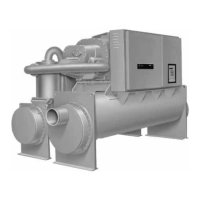Gas Pump Checkout
54 RTHC-SVD01B-EN
leaking solenoid valve (22). Further testing may be necessary to
determine which component is leaking.
9. Before returning to service, make sure all valves and coils are
returned to their normal positions.
10-3. Gas Pump Checkout Procedure - Unit On
To check the operation of the Gas Pump while the chiller is ON, refer to
RTHC-SB-1B to do the following procedure:
Important: At least a 50 psi differential must exist between the evapo-
rator and condenser before performing this test.
1. Turn the compressor off and close the valve on the oil return line
from the Gas Pump to the compressor (49).
2. Back seat valve and Install gauge at (47). Re-open to read prea-
sure.
3. Allow the unit to start.
4. Allow the Gas Pump to enter and complete a "fill" cycle (valve 22
will energize).
5. Allow the Gas Pump to enter a “drain” cycle (valve 22 will de-
energize and valve 23 will energize). During the drain cycle de-
energize the fill solenoid. Unplug J4-1 and J4-2 from the Chiller
Module (1U1). Verify that the correct coil is de-energized. Or
remove the electric coil from the valve (to disable the valve) and
place a screwdriver or bolt shaft through the coil center to prevent
overheating of the coil.
6. Monitor the gauge pressure at angle valve (47). The pressure
should build toward condensing pressure. At the completion of
the drain cycle de-energize the drain solenoid. Unplug J6-1 and
J6-2 from the Chiller Module (1U1). Verify that the correct coil is
de-energized. Or remove the electric coil from the drain valve (23)
to disable the valve and place a screwdriver or bolt shaft through
the coil center to prevent overheating of the coil. If the pressure
holds to within 10 psi in 5 minutes, the system is functioning nor-
mally.
7. If the pressure fails to hold near condensing pressure, there may
be a solenoid valve (22) or a check valve (24) leakage.
8. If the pressure falls rapidly to or near suction, either the "fill" sole-
noid (22) or the check valve (24) is leaking by.

